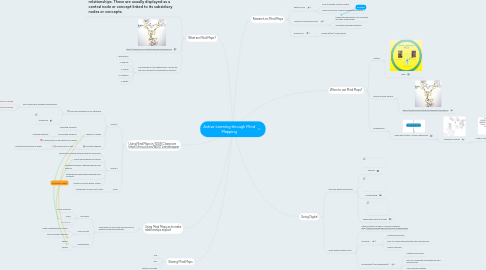
1. What are Mind Maps?
1.1. A graphic representation of concepts and their relationships. These are usually displayed as a central node or concept linked to its subsidiary nodes or concepts.
1.2. https://www.flickr.com/photos/waiferx/6196378079
1.3. Trial Example on the Whiteboard: How do we get more students to participate in section?
1.3.1. 1. Brainstorm
1.3.2. 2. Reduce
1.3.3. 3. Group
1.3.4. 4. Organize
1.3.5. 5. Relate
2. Using Mind Maps as to make relationships explicit
2.1. What kinds of mind map exercises fit for different classroom settings?
2.1.1. Discipline
2.1.1.1. Social Sciences
2.1.1.2. STEM
2.1.1.3. Humanities
2.1.2. Class Format
2.1.2.1. Large Undergraduate Lecture
2.1.2.2. Small Graduate Seminar
2.1.3. Assessments
2.1.3.1. Papers
2.1.3.2. Exams
3. Using Mind Maps in YOUR Classroom https://tinyurl.com/WUSTLmindmapper
3.1. Group 1
3.1.1. break into elements of my discipline
3.1.1.1. see connections between the elements
3.1.1.1.1. explore how concepts are related
3.1.1.1.2. understand processes
3.1.1.2. transitions
3.1.2. ideas for a paper
3.1.2.1. collecting evidence
3.1.2.2. connecting evidence
3.1.2.2.1. ordering evidence
3.1.2.3. crafting ideas or arguments for a paper
3.1.3. concept mapping
3.1.3.1. Preparing for a test
3.1.3.1.1. Brainstorming before an exam
3.2. Group 2
3.2.1. connections among historical events and novels
3.2.2. Using mind mapping for exams
3.2.3. Identifying themes regarding gender and science
3.2.4. establishing relationships between main concepts
3.2.5. related concepts within a topic
3.3. Anne
3.3.1. Assignment to flesh out a topic
4. Sharing Mind Maps
4.1. Link
4.2. PDF
4.3. Export as Outline
5. Going Digital
5.1. Why use digital mind maps?
5.1.1. Sharing
5.1.2. Collaborating
5.1.3. Seeing the Forest and Trees
5.2. What digital options exist?
5.2.1. Kathy Schrock's Guide to Concept Mapping http://www.schrockguide.net/concept-mapping.html
5.2.2. Mindmup
5.2.2.1. Limited free version
5.2.2.2. Easy to collaborate separately and anonymously
5.2.2.3. Simple interface
5.2.3. Mindmeister (this presentation)
5.2.3.1. Limited free version
5.2.3.2. Easy to collaborate simultaneously and anonymously
5.2.3.3. User-friendly interface
5.2.3.4. Features like revision history
6. Research on Mind Maps
6.1. Eppler 2006
6.1.1. Easy to extend course content
6.1.2. Easier to process complex relationships quickly
6.2. Nesbit and Adescope 2006
6.2.1. Deeper thinking about core concepts and their relationships
6.2.2. Increase knowledge retention
6.3. Budd 2004
6.3.1. Enhance(d by) collaboration
7. When to use Mind Maps?
7.1. Lecture
7.1.1. Prezi
7.2. During Section Review
7.2.1. https://www.flickr.com/photos/waiferx/6196378079
7.3. Assignments
7.3.1. "Who was Kircher?" Group Assignment
7.3.1.1. Assigned in pieces
7.3.1.1.1. Used in class discussion

